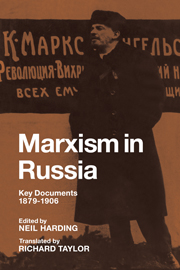Book contents
- Frontmatter
- Contents
- Acknowledgements
- Preface
- Introduction
- DOCUMENTS
- Section 1 1879–1893: theoretical foundations and worker projects
- Section 2 1894–1897: bridges to the workers – economic agitation
- Section 3 1898–1902: political agitation and the critics of orthodoxy
- Section 4 The Bolshevik/Menshevik dispute – organisational questions and appraisals of the 1905 revolution
- Notes
- List of sources
- Guide to further reading
- Glossary
- Index
Section 3 - 1898–1902: political agitation and the critics of orthodoxy
Published online by Cambridge University Press: 05 November 2011
- Frontmatter
- Contents
- Acknowledgements
- Preface
- Introduction
- DOCUMENTS
- Section 1 1879–1893: theoretical foundations and worker projects
- Section 2 1894–1897: bridges to the workers – economic agitation
- Section 3 1898–1902: political agitation and the critics of orthodoxy
- Section 4 The Bolshevik/Menshevik dispute – organisational questions and appraisals of the 1905 revolution
- Notes
- List of sources
- Guide to further reading
- Glossary
- Index
Summary
41. MANIFESTO OF THE RUSSIAN SOCIAL DEMOCRATIC LABOUR PARTY (MARCH 1898)
P. Struve
Fifty years ago the invigorating storm of the 1848 revolution swept across Europe.
For the first time the modern working class appeared on the scene as a major historical force. Through its efforts the bourgeoisie was able to sweep away many outmoded feudal–monarchical customs. But the bourgeoisie rapidly perceived in its new ally its most dangerous enemy, and betrayed both itself and its ally, and the cause of freedom, into the hands of reaction. It was, however, already too late: the working class, temporarily suppressed, reappeared on the stage of history ten to fifteen years later, with redoubled strength and enhanced self-consciousness as a fully mature warrior for its own ultimate liberation.
Throughout this whole period Russia apparently stood aside from the mainstream of historical development. There was no obvious class struggle in Russia but it was there and, what is important, it was continuing to mature and grow. The Russian government, with commendable zeal, itself implanted the seeds of the class struggle, treating the peasants unfairly, protecting the landowners, rearing and fattening the great capitalists at the expense of the toiling population. But the bourgeois-capitalist order is unthinkable without a proletariat or a working class. The latter comes into being at the same time as capitalism, grows with it and, as it grows, is increasingly drawn into conflict with the bourgeoisie.
The Russian factory worker, serf and freeman has always fought a covert and an overt battle with his exploiters.
- Type
- Chapter
- Information
- Marxism in RussiaKey Documents 1879–1906, pp. 221 - 276Publisher: Cambridge University PressPrint publication year: 1983



